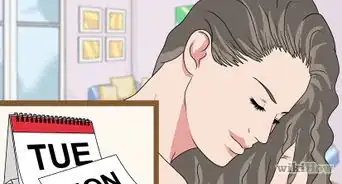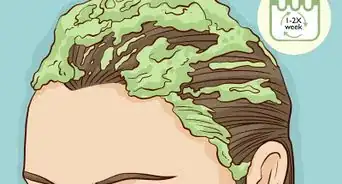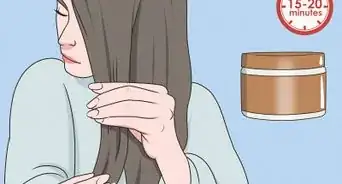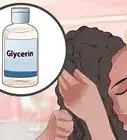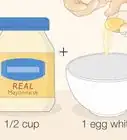This article was co-authored by Gina Almona. Gina Almona is the Owner of Blo It Out, a New York City-based hair salon. With over 20 years of beauty training experience, Gina's work has been featured in People Magazine, Time Out New York, and Queens Scene. She has been able to keep a fresh perspective in the industry by demonstrating and participating in trade shows and workshops like the International Beauty Show. She received her cosmetology training from the Long Island Beauty School, Astoria.
This article has been viewed 50,896 times.
Conditioning your hair keeps it shiny, smooth and free of frizz. It’s a good idea to condition your hair lightly after each shampoo, focusing mostly on the tips of your hair since they dry out more easily than the roots.[1] Then, once every few weeks, deep condition your hair with something rich like coconut oil to give it a deep, glossy shine.
Steps
Everyday Conditioning
-
1Condition after every shampoo. Shampoo is designed to cleanse the hair of dirt and oils. Washing away the natural oils your scalp produces is necessary for your hair to look clean, but it can dry out your hair. That’s where conditioner comes in. Each time you shampoo, follow up by using conditioner that’s right for your hair type.[2]
- If you have very dry or damaged hair, choose a moisturizing conditioner that will restore its shine.
- If you have fine, light hair, choose a lighter conditioner that won’t make your hair look limp.
-
2Use only as much as you need. When it comes to conditioner, you can definitely have too much of a good thing. You should only use as much as you need for your hair type and length.[3] If you use a handful of conditioner your hair will end up looking dull and even greasy. Use just enough to lightly coat your hair and make it easy to untangle the strands.
- If you have short hair, you only need a dime-sized amount of conditioner.
- If you have medium hair, use a quarter-sized amount.
- For long hair, use a silver dollar-sized amount.
Advertisement -
3Focus on the tips of your hair.[4] Since your scalp produces its own natural oil, your roots don’t need to be conditioned as much as your tips. The tips dry out much more easily, leading to frayed and split ends. When you condition your hair, work the conditioner between your palms and finger-comb it in starting at least an inch from your scalp. Comb it down to the tips and gently rub it in. Then go back and massage your scalp and roots with the tiny bit of conditioner that remains on your hands.[5]
-
4Rinse thoroughly when you’re finished. After rinsing there will still be a light coating of conditioner on your hair. You want enough to provide moisture and a protective layer against the elements, but not enough to weigh your hair down or make it look greasy. Finger-comb your hair as you rinse to make sure there are no areas with a lot of conditioner build up.[6]
-
5Shampoo less often to keep your hair from drying out. You shouldn’t have to shampoo and condition your hair more than twice a week, and three times tops. When you shampoo, the natural oils your scalp produces get washed away, and no conditioner can really replace them when it comes to keep your hair healthy and shiny. Plus, when you wash your hair too often the glands in your scalp go into overdrive to produce more oil, and your hair ends up looking greasy much faster.
- When you first stop shampooing every day, your hair will look greasy pretty quickly. Ride it out for as long as you can (hats are very helpful for this). The next time you shampoo and condition your hair, it will take longer for your hair to look dirty.
-
6Consider getting silicone-free conditioner. If your hair tends to look dull even though the products you use claim they’ll make it look shiny and sleek, you may want to switch your products. Silicones are an ingredient in commercial conditioners that do indeed make hair look shiny – at first. After awhile, though, the silicones build up in your hair and cause it to lose its shine. Look for conditioner that’s labeled “silicone-free” and you won’t have to worry about this problem.[7]
- You may also want to get sulfate-free shampoo. Sulfates strip hair of its natural oils very effectively – too effectively. If your hair is on the dry side, using shampoo with sulfates will dry it out even more, and no conditioner will be able to make it look healthy again. Use a sulfate-free shampoo paired with a silicon-free conditioner.
-
7Look into leave-in conditioner. This is a great choice for those with hair that tends to get dry and frizzy. Rather than rinsing the conditioner out, you spray it on or comb it through your hair and leave it in as your hair dries. If your hair is very fine or tends to get greasy easily, this may not be the best choice for you.
Deep Conditioning
-
1Deep condition once every few weeks. You don’t need to deep condition more often than this; in fact, deep conditioning too much can actually damage your hair and cause it to break more easily. Once every week and a half or two weeks should be sufficient. You know it’s time to deep condition when your hair feels a bit dry, or the ends seem ready to split.
-
2Choose a deep conditioner. There are hundreds of store-bought deep conditioners to choose from, and salons offer deep conditioning treatments as well. However, if you don’t want to spend money on a deep conditioner, you can use household ingredients that are just as effective. Here are a few deep conditioners you probably have on hand:
- Coconut oil (unrefined)
- Olive oil
- Mayonnaise
- Almond oil
-
3Comb a tablespoon or so through your hair. Use a little less if your hair is short, or a little more if your hair is long. Apply it near the roots and comb it through your hair to the tips, making sure every strand gets covered. A wide-toothed comb is a great tool for the job, or you can just use your fingers.[8]
-
4Put on a shower cap. This will trap your body heat against your head, gently heating the deep conditioner and helping it become more effective. Plus, it will keep the conditioner from getting all over your clothes and furniture. If your hair is long, you can put it up in a clip, then cover that with a shower cap.[9]
- If you don’t have a shower cap, use plastic wrap or a plastic bag pinned around your hair.
- Be sure to use something that’s nonporous, rather than porous material like a towel or t-shirt that will let the heat escape.
-
5Let it sit for at least an hour. An hour will be enough time for the deep conditioner to penetrate your hair and work its magic. If you have time to spare, you may keep it in your hair for several hours or even overnight.
-
6Shampoo it out. In some cases you may need to shampoo two or three times to rinse it all away. This is especially true with coconut oil and olive oil, which are both very rich oils that aren’t easy to wash out. Wash your hair until it no longer feels as though it’s covered in oil. When you dry your hair, it will silky and bouncy.
Conditioning for Very Dry Hair
-
1Use hair masks. These can be used more often than deep conditioners. They aren’t meant to penetrate your hair, but to provide a light mask that keeps moisture in and protects your hair. Comb about a tablespoon of the mask into your hair after wetting it at the beginning of your shower, then shampoo it out after about then minutes. You can buy a hair mask from the store or make your own using one of the following:
- Honey
- Egg whites
- Milk or yogurt
-
2Use a boar-bristle brush to distribute your natural oils. Boar bristle brushes are designed to pull the sebum produced by your scalp from the roots of your hair to the tips, so that the entire length of your hair will receive the benefits. They don’t cause breakage or damage like plastic brushes. Boar bristle brushes are difficult to get through very curly hair, but they work well for people with wavy or straight hair.
-
3Try going no-poo. People with very curly or kinky hair have found a solution to dryness and frizz: stop using shampoo altogether. Instead of shampooing, then conditioning, try using conditioner to wash your hair. Wet your hair at the beginning of your shower, massage conditioner into your scalp and hair from the roots to the tips, then rinse it away. This technique would weigh thin hair down, but it works for those with thick, dry hair.
-
4Cut back on frizz. People with dry hair often have frizz to go along with it. There are a few changes you can make to your routine to cut back on and potentially eliminate frizz altogether. Try the following:
- Blot your hair dry instead of roughly toweling it
- Let your hair air dry instead of using a hair dryer; save heat styling for special occasions
- Use a wide-toothed comb instead of a brush
- Handle your hair as little as possible throughout the day
-
5Use a finishing oil. Finishing oil is similar to leave-in conditioner, but it provides a little extra protection for hair that tends to get really dry.[10] Hair oils and serums are available for purchase at salons and beauty supply stores. Look for products that contain the following:
- Argan oil
- Moroccan oil
- Jojoba oil
- Rosehip oil
Expert Q&A
Did you know you can get expert answers for this article?
Unlock expert answers by supporting wikiHow
-
QuestionHow do you properly apply conditioner?
 Gina AlmonaGina Almona is the Owner of Blo It Out, a New York City-based hair salon. With over 20 years of beauty training experience, Gina's work has been featured in People Magazine, Time Out New York, and Queens Scene. She has been able to keep a fresh perspective in the industry by demonstrating and participating in trade shows and workshops like the International Beauty Show. She received her cosmetology training from the Long Island Beauty School, Astoria.
Gina AlmonaGina Almona is the Owner of Blo It Out, a New York City-based hair salon. With over 20 years of beauty training experience, Gina's work has been featured in People Magazine, Time Out New York, and Queens Scene. She has been able to keep a fresh perspective in the industry by demonstrating and participating in trade shows and workshops like the International Beauty Show. She received her cosmetology training from the Long Island Beauty School, Astoria.
Professional Hair Stylist
References
- ↑ Gina Almona. Professional Hair Stylist. Expert Interview. 12 December 2019.
- ↑ https://www.aad.org/public/skin-hair-nails/hair-care/tips-for-healthy-hair
- ↑ Gina Almona. Professional Hair Stylist. Expert Interview. 12 December 2019.
- ↑ Gina Almona. Professional Hair Stylist. Expert Interview. 12 December 2019.
- ↑ https://www.goodhousekeeping.com/beauty/hair/a33576/hair-conditioner-tips/
- ↑ https://www.goodhousekeeping.com/beauty/hair/a33576/hair-conditioner-tips/
- ↑ https://www.getthegloss.com/article/are-silicones-good-or-bad-for-your-hair
- ↑ https://www.thehairstyler.com/features/articles/hair-care/hair-care-how-to-deep-conditioning-hair-at-home
- ↑ https://www.thehairstyler.com/features/articles/hair-care/hair-care-how-to-deep-conditioning-hair-at-home

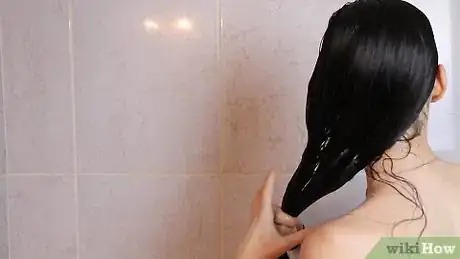



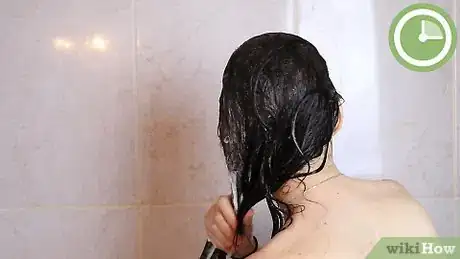
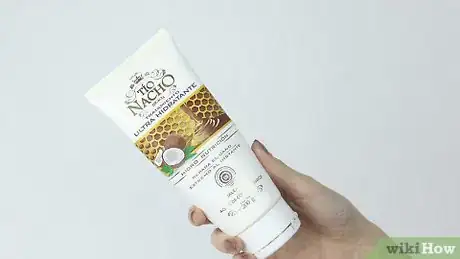

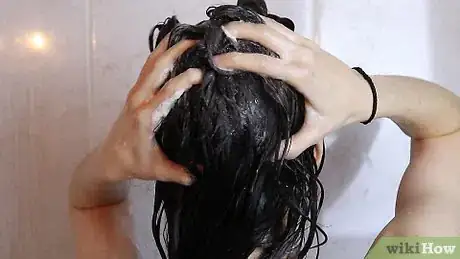
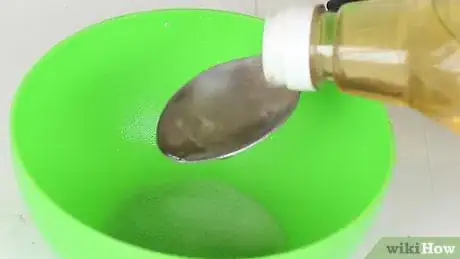

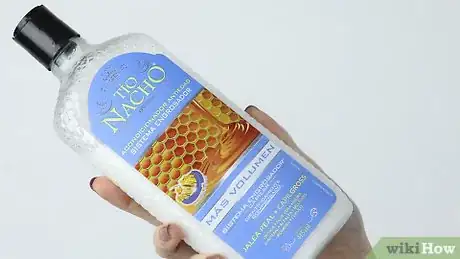

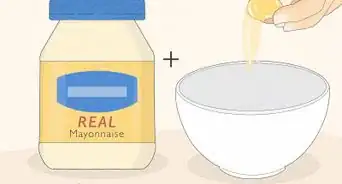
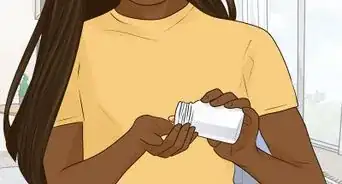
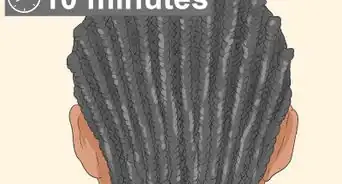


-Step-13.webp)
